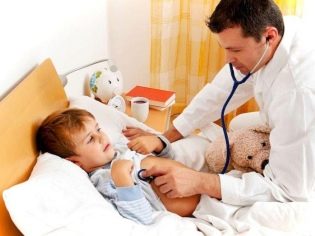White fever in a child
Everyone knows that fever has an important protective function for the body - it helps the immune system to fight the invasion of alien bacteria and viruses. However, some types of fever can be deadly for a child’s body. White fever is one of these species. With her, the child has high fever and cold limbs. If you want to know why the state is developing, how to help your baby, read this article.
What it is?
Fever itself is not considered a disease. It develops as a defensive reaction with a large number of acute infectious and inflammatory diseases. The apparatus responsible for thermoregulation reacts with fever (for special substances that penetrate from the outside, pyrogens).
Usually they are not independent substances, but components of various pathogenic microorganisms, viruses. They act at the level of the brain - shifting the point in the center of thermoregulation, which is located in the hypothalamus.
Medicine is familiar with different types of fever, but all of them (regardless of the cause) are conventionally divided into red and pale, so marked by the basic color of the skin during the disease. The second is white fever.
High temperatures are needed by the body, because during illness it stimulates the production of interferons, proteins necessary for the processes of immune protection. However, too much heat becomes dangerous for the baby by itself.
White fever is accompanied not only by high temperature, but also by impaired blood circulation, as well as an imbalance between the body's production of heat and its effects. A spasm of peripheral vessels develops, and it is very dangerous, especially for babies from birth to one year.
Symptoms and signs
White fever - a name that as fully as possible reveals the essence of the child's condition. At high temperatures, the child looks pale, his lips, nasolabial triangle acquire a bluish tint, there are bluish circles under the eyes. On the skin, you can see a bluish vascular mesh, and for this feature, the skin with white fever is sometimes called "marble". Hands and feet due to impaired blood circulation become cold, almost icy.
Many babies even with high heat feel quite vigorously. In the case of white fever, everything is different - the child is very sluggish, there are all symptoms of intoxication, he is very weak.
Pulse in crumbs speeded up, changes in heart rate can be observed. Children who can express their complaints in words may complain of feeling cold, they have a pronounced chill. Blood pressure may be elevated. At temperatures above 39.0 degrees, hallucinations and clouding of consciousness may occur, the child begins to wander, and often febrile seizures begin.
The main and main symptom to distinguish white fever from any other is cold hands and feet. If parents notice this, they must provide emergency assistance to the child. If the temperature is above 39.0 degrees, you need to call an ambulance.
An additional diagnostic measure can be considered "pale test". If the skin is slightly pressed by the thumb, with a white fever there is a bright spot that can not restore the natural color for the skin for a long time.
First Emergency
First aid for white fever is to warm the child’s limbs, restore vascular permeability, and ensure blood flow.To do this, it is strictly forbidden to use the methods of heat removal so popular among the people - cold rubbing and wrapping. This will only lead to even more significant heat loss, and the baby’s condition will worsen. In case of a pale fever, in no case should the child be rubbed with alcohol, vodka, alcohol-containing compounds, be wrapped in a cold and wet sheet.
You should call an ambulance, and in anticipation of the arrival of the medical team, rub the child’s arms and legs with light massaging movements, holding them between his palms.
You can use any source of heat - a heating pad, a bottle of warm water. At the same time give antipyretic drugs.
For children, paracetamol-based preparations are considered optimal. Can be given in the age dosage anti-inflammatory nonsteroid drug Ibuprofen. Do not give two or more antipyretic drugs at the same time. Aspirin and drugs based on it should be avoided, since its use in childhood can provoke the occurrence of severe and very dangerous for the life of the child Ray's syndrome.
If during normal fever, antipyretic drugs are given to children in different dosage forms (tablets, suppositories, syrups, powders), then in white fever it is worthwhile to limit this list to tablets or syrups. Introduction of rectal suppositories may be ineffective due to vasoconstriction.
To eliminate vasospasm, you can give your child antispasmodic drugs. After a year - "No-shpu"up to year "Papaverine", but in a strict age dosage. If there are doubts about the required amount of the drug, it is better to wait for the arrival of the doctors.
At high temperatures, ambulance crew doctors give children a "lytic" injection, it also contains a spasmolytic (usually Papaverin), and anesthetic and antipyretic "Analgin". Sometimes antihistamines are injected into a lytic injection — for example, "Suprastin" (to reduce the swelling of mucous membranes and prevent the development of croup, edema, and severe complications).
Before the arrival of the ambulance, it is imperative to provide warmth, but do not overheat the child so that the heat does not begin to increase. In addition, should give plenty of water to the child warm drinks. This will help reduce the risk of dehydration, febrile seizures. If the child refuses to drink on his / her own, you need to use a syringe without a needle and pour in a drip (or water the baby with a teaspoon).
Forcing a child with a white fever to eat is a parental offense. First, the baby has absolutely no appetite, and secondly - the body needs strength to fight the infection that caused the fever, and not to digest food. That is why nature has invented everything so that the appetite for the disease disappears one of the first and appears one of the last.
Treatment
Usually, it is recommended to give antipyretics to children at a temperature of from 38.5 to 39.0 degrees. However, in the case of the white fever with the assistance (including medication) can not be slow. Even if the thermometer has not yet reached 38.5, you still need to give a fever and call an ambulance.
The most prompt response should be to the appearance of the so-called cold white fever in infants, in children up to three years old, in children with impaired functions of the central nervous system, with neurological diagnoses, in children who have previously suffered convulsions at least once, as well as in children with diseases and defects of cardio-vascular system.
It should be noted that the temperature during white fever decreases after taking the drugs a little slower than with the red form of fever. Sometimes you need to wait more than an hour and a half. That is why it is best to immediately call a brigade of doctors.
White fever does not require specific treatment.When the acute stage, which is dangerous from the point of view of seizures and dehydration, is stopped, the doctor will prescribe a treatment that corresponds to the main diagnosis.
White fever usually accompanies the following diseases: ARVI, flu, sinusitis, otitis media, bronchiolitis, pneumonia, pharyngitis, pyelonephritis, meningitis, chickenpox, measles. It is also an inadequate response of the child’s body to the post-vaccination period.
In viral infections, the doctor will prescribe a symptomatic treatment, to relieve the symptoms of fever - antipyretic drugs. For bacterial diseases, he will prescribe antibiotics while taking antipyretic drugs.
It is strictly forbidden to do inhalations (especially steam ones), rub baby’s badger oil, do warming compresses (except dry heat on the limb in the acute stage), practice cold and cool baths. All this is allowed after the temperature decreases.
In this video, Dr. Komarovsky talks about emergency care at elevated body temperature in a child.






























